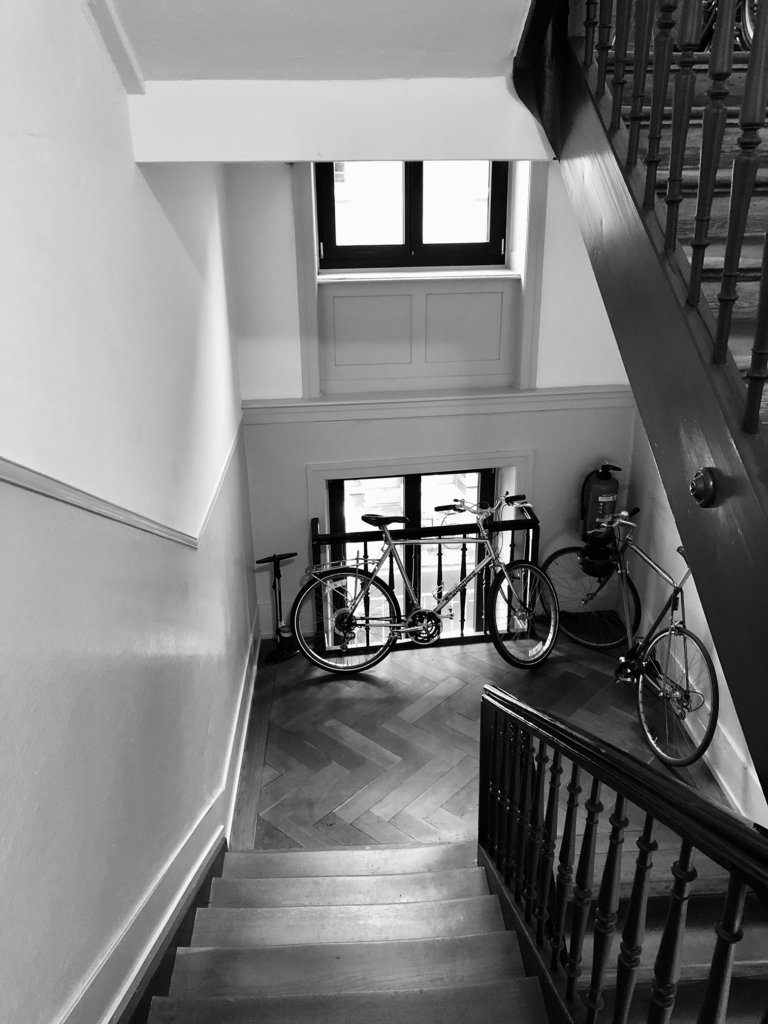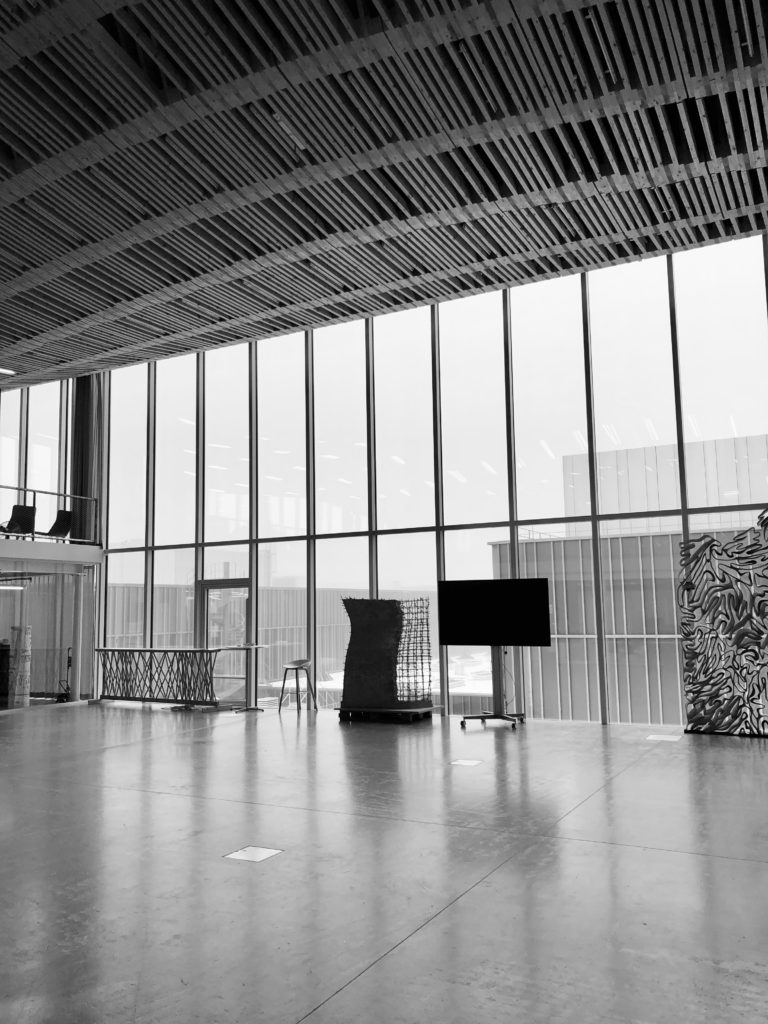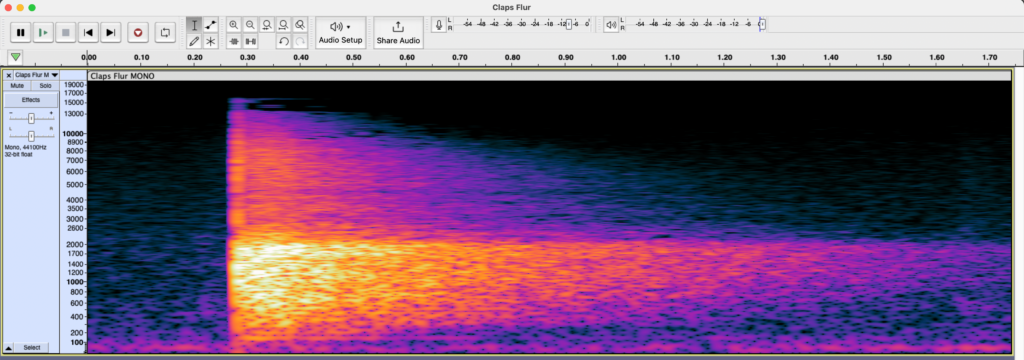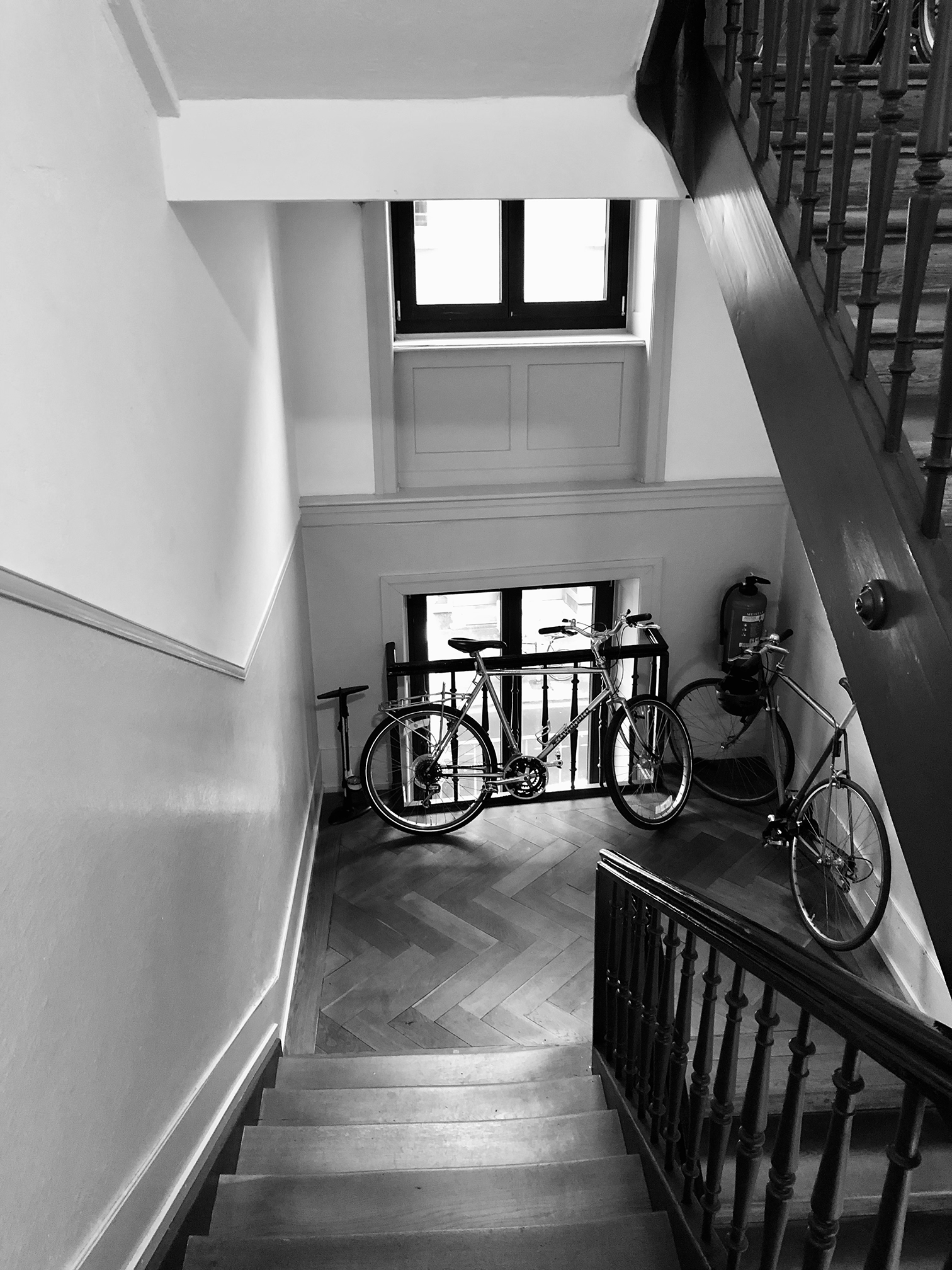01 Exploring Sound Qualities in Architectural Design
Room 1: Staircase
I live in an apartment on the third floor, which I access via a staircase whose steps, banisters and wall paneling are made of wood. Different sounds and acoustic qualities can be perceived here.
When I’m standing still, I can mainly hear the road noise coming through the windows into the stairwell. Although all sounds are muffled, it’s still easy to tell whether it’s a large vehicle passing by, such as a bus or truck, or smaller cars. The sounds are also dampened by the wood that lines the entire stairwell. If the street quietens down for a moment, other noises can be heard. Irregular noises can be heard from various surrounding apartments like sounds from a coffee machine or other kitchen devices. You can also hear very quiet individual noises that seem to come from water pipes. Otherwise, the room feels very quiet and isolated. The wood moreover creates a certain acoustic warmth.
The wooden steps can produce a slight creaking sound when entering and leaving the staircase from my flat, giving the room a certain warmth and character. But when walking up or down the stairs they produce a very loud and disturbing creaking that will echo through the whole stairwell. Therefore you can easily tell how many other people are there on other floors. When I clap I can hear a surprisingly long reverb and reflections from the surrounding walls.
Floor no movement:
Walking down the stairs:
Floor claps:

Room 2: Railroad underpass
The acoustics and sounds in a concrete railroad underpass are very different to those in a stairwell with wooden steps. The concrete structure causes sounds to be strongly reflected, creating a reverberant or echo-like sound atmosphere. Footsteps or other noises are amplified and transmitted by the materiality and shape of the tunnel. For example, I can already clearly hear a person’s footsteps, even if they are still a few meters away at the entrance of the tunnel. It seems to me as if different sounds are quickly superimposed on each other in this place and, due to the strong reflections, it is not always so clear and precise to locate the sound when I close my eyes and listen. The mixing of different sounds can lead to a loud and intense soundscape. Then again it becomes rather quiet for short moments. In particular, the sounds of passing trains above me or other means of transportation in the tunnel are clearly audible. The passing trains produce a very loud, damp area sound with lots of low frequencies. The acoustic quality of this space depends heavily on the size of the underpass, the quality of the concrete and other factors such as the presence of sound absorbers or reflectors. However, I cannot find any absorbent materials here. Overall, I would describe this place as an interesting and reverberant sound environment. The shape of the tunnel and the smooth concrete amplify the noises many times over. When I clap I can clearly hear the reverberation and the fading of the repeated sound.
Underpass:
Claps:

Room 3: HIT Seminar Room at ETH
One of my seminars takes place at the HIT building on the ETH campus at the far back of the big hall. We are a small group of about 10 to 12 people and each week we go there, the arrangement of the chairs and tables is different. Most of the times we would rearrange the chairs and form a circle around the screen and the lecturer. Most of the lectures are held online via Zoom and the sound would come from a speaker set in front of the screen. The seminar starts quiet early at 7:45 in the morning so the building is still mostly empty. That is the only reason why it works to hold the seminars there. It is a beautiful room with a great view and this incredible wooden ceiling. But acoustically it is pretty difficult. Whenever people enter their offices on the same floor or on the upper maisonette level it produces a lot of disturbing sounds. Since it is an open space the sound is transmitted without being absorbed in any way and even quiet sounds can become very audible. At around 9:30 it feels a bit like sitting in a arena of various sound sources reaching from the coffee machine to smashing doors or conversations between people. Sitting quite close to the reflecting windows helps to improve the acoustics in the way that the sound from the speaker becomes louder but it would definitely need some improvements to make it a room for lecturing.

So whenever we can and the group is small enough we try to move to smaller seminar rooms like the one on the picture below. Sounds from the main hall are still entering here but the glass cube and the acoustic panels on two sides help a lot to improve the overall acoustic quality of the room. There is still a strong (of course also visible) connection to the kitchen, where people would make their coffee, that can be distracting and also the glass cube without ceiling is not able to reduce the kitchen sounds fully but the room size especially when it is filled with people and the additional acoustic panels make it for me a lot easier to stay focused on the lecture. The high wooden ceiling is also improving the acoustic qualities because the sound waves are distributed

02 Exploring the Emotional Impact of Everyday Sounds
Location 1: A park bench near the river
I’m in a park right next to the Limmat on a fall day and close my eyes. What do I hear? Most clearly, I hear the rushing of the river and a gentle lapping of the water coming from the bank where small waves crash against the stones. I also hear an occasional gurgling of the water, which seems to come from near a bridge. On the bridge, which is not far from me, I hear the rattling of bicycles and scooters, accompanied by the sound of tires on the asphalt. It’s late afternoon and I can hear lots of birds and the sounds of insects. Some of the birds are sitting in a bush near me and the loud chirping interrupts the other sounds. In the distance, I can hear the dampened roar of car traffic. The water and the noise of the cars in the distance combine to form a relaxing background scenery, which after a while I no longer hear explicitly, but which fades into the background of my acoustic perception. The bicycles and birds, but also the voices of people walking past, are superimposed, intensifying and varying the soundscape. It is interesting that as soon as I have simply listened for a while, I can concentrate explicitly on one sound and now the others become quieter, as if I were adjusting their volume. The selected sound now seems much clearer and detached from the soundscape which gives me the opportunity to carefully listen to it.
The sound of the river and the gentle rippling have a calming and relaxing effect, triggering a sense of peace and serenity. The rattling of bicycles and scooters create a lively and dynamic atmosphere, conveying a sense of energy and activity. The muffled roar of car traffic suggest a sense of distance and space contradicting the closer more peaceful sounds.
Location 2: Busy coffee shop:
I am in a relatively small café with a stone floor, wood paneling on the walls and bar, and a large glass window facing the square in front of the café. Sounds that particularly catch my attention are:
- Conversations: the café is filled with the hum of conversation as people interact and converse with each other. This soundscape changes constantly, sometimes it is relatively steady, then again very loud and lively. Again and again it is interrupted by individual significant noises like raising voices or laughters.
- Laughter: The laughter of people having fun or exchanging jokes can be heard particularly loudly. The frequency of the laughing is often relatively high, so that they clearly stand out from the other more flat atmospheric sounds.
- Clattering of crockery: The clattering of cups, plates and cutlery can be heard particularly clearly when guests are having their drinks and food. You can also hear the humming of machines and the clattering of kitchen utensils from the kitchen, but only because I’m sitting near the door to the kitchen, which opens from time to time.
- Coffee machine: The humming and hissing of the coffee machine while the barista prepares coffee is also clearly audible. The significant sound of the milk frother and the loud humming as the coffee is pressed through the machine.
- Background music: The café plays background music that mixes with the voices and, depending on the genre, is very relaxing or very annoying from time to time.
As soon as I start focusing on my laptop or on a conversation with someone this intense mix of sounds and voices becomes a vivid background noise that is busy and vivid yet surprisingly not too disturbing.
03 Empirical and numerical estimation of room acoustic properties
Location: Stairway
Clapsound

I calculated the reverberation time RT60 in the stairwell of my apartment.
I measured a decrease of 30 db in 0.88 seconds.
So the reverberation time would be: RT60 = 0.88 sec x 2 = 1,76 sec
I thought the reverberation time would be kind of long but I honestly didn’t expect it to be that long and was quite surprised from the results.

This is how the spectogram of the recording looks.
For me echoes are not very clearly visible in the impulse decay.



